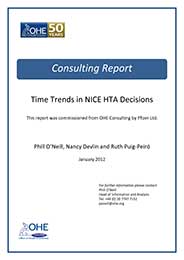Sign up to our newsletter Subscribe
Analysing Global Immunisation Expenditure

Sign up to our newsletter Subscribe


According to the 1999 UK Department of Health consultation document, the fundamental purpose of the National Institute for Health and Clinical Excellence (NICE) was to reduce inequalities in access to innovative care and ensure more rapid access to medicines identified…

According to the 1999 UK Department of Health consultation document, the fundamental purpose of the National Institute for Health and Clinical Excellence (NICE) was to reduce inequalities in access to innovative care and ensure more rapid access to medicines identified as being of value to the NHS. Since NICE’s debut in April 1999, several analyses have examined the uptake of technologies that have been considered by NICE, but no evidence had been published on whether and how NICE’s health technology appraisal (HTA) processes may have affected the speed of access to new treatments.
According to the 1999 UK Department of Health consultation document, the fundamental purpose of the National Institute for Health and Clinical Excellence (NICE) was to reduce inequalities in access to innovative care and ensure more rapid access to medicines identified as being of value to the NHS. Since NICE’s debut in April 1999, several analyses have examined the uptake of technologies that have been considered by NICE, but no evidence had been published on whether and how NICE’s health technology appraisal (HTA) processes may have affected the speed of access to new treatments.
This report examines two aspects of the impact of the HTA process on access. First, it examines the elapsed time between launch of a medicine to publication of a technology appraisal. If availability is delayed until NICE has published its appraisal, then this interval is an important determinant of speed of access. Second, the report analyses elapsed time between the start and completion of the technology appraisal process itself. The clear timelines established for NICE allow benchmarking of performance. Included also are changes in elapsed time for the process over the years; how elapsed time has been affected by the introduction of the single technology appraisal (STA) process; and any specific factors that may account for different elapsed times across decisions.
Download O'Neill, P., Devlin, N. and Puig-Peiró, R. (2012) Time Trends in NICE HTA Decisions. OHE Consulting Report. London: Office of Health Economics.
Also see our subsequent blog post commenting on the Daily Mail's misinterpretation of this study. Click here.
An error has occurred, please try again later.
This website uses cookies so that we can provide you with the best user experience possible. Cookie information is stored in your browser and performs functions such as recognising you when you return to our website and helping our team to understand which sections of the website you find most interesting and useful.
Strictly Necessary Cookie should be enabled at all times so that we can save your preferences for cookie settings.
If you disable this cookie, we will not be able to save your preferences. This means that every time you visit this website you will need to enable or disable cookies again.
This website uses Google Analytics to collect anonymous information such as the number of visitors to the site, and the most popular pages.
Keeping this cookie enabled helps us to improve our website.
Please enable Strictly Necessary Cookies first so that we can save your preferences!